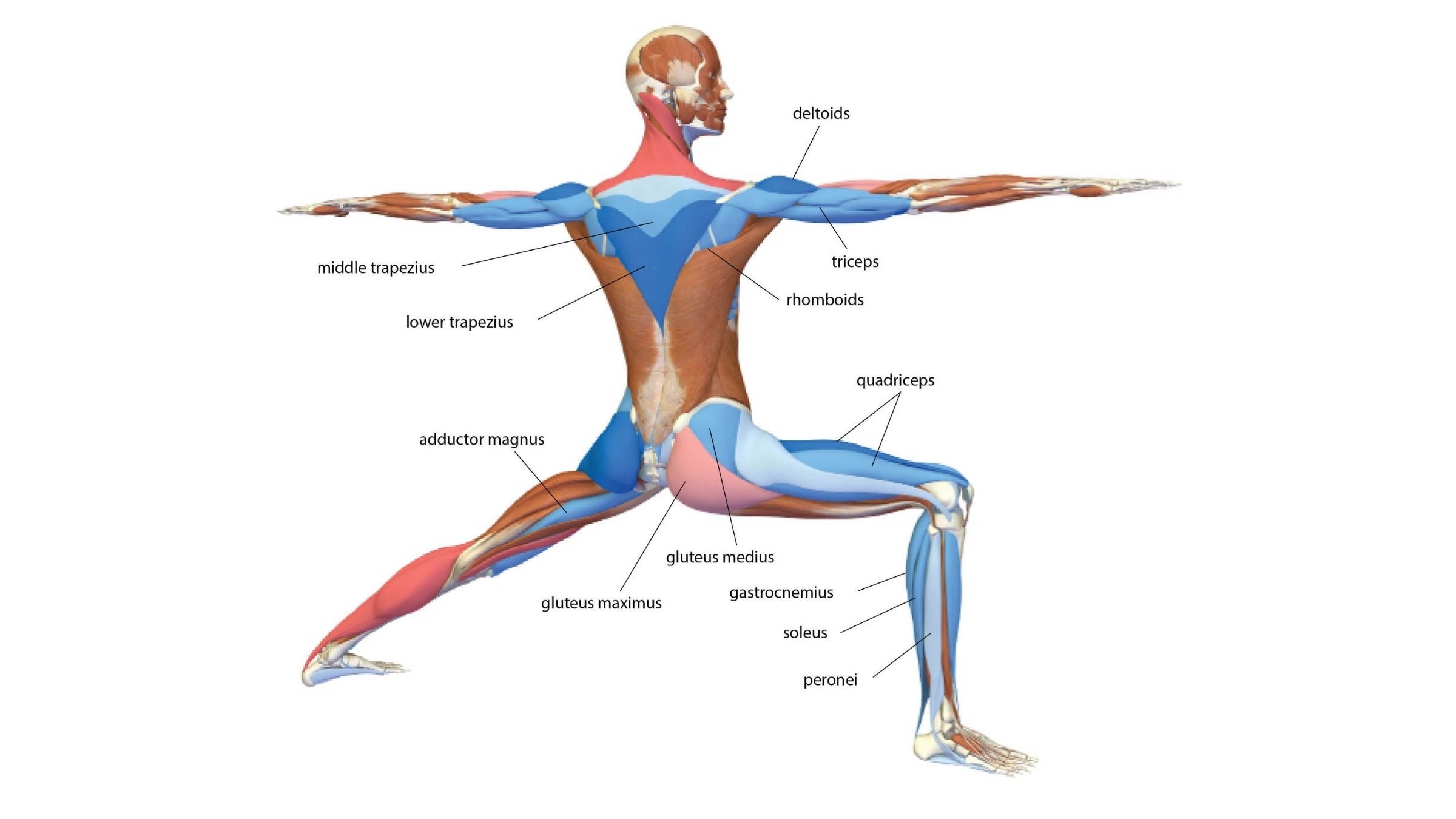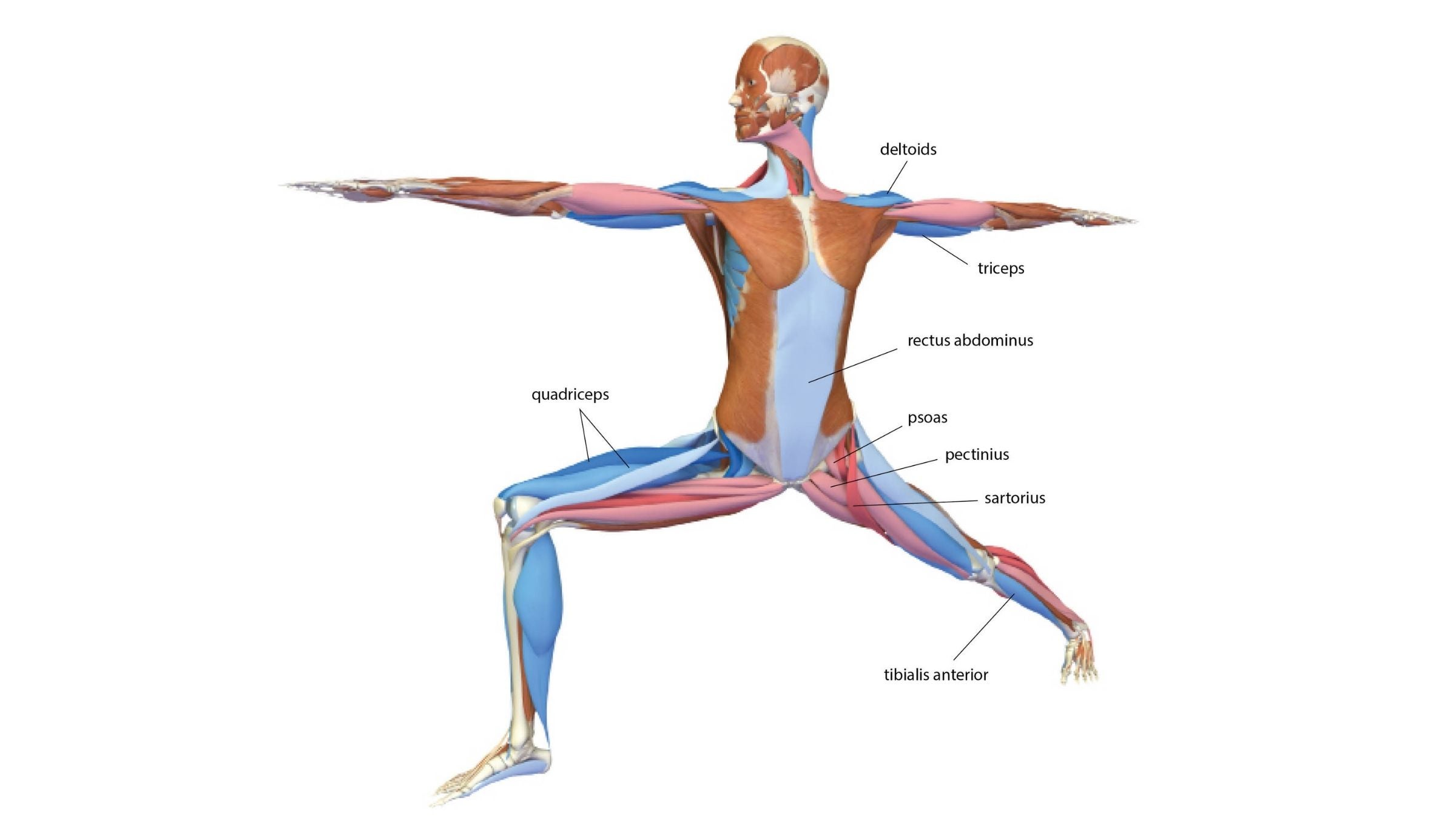Heading out the door? Read this article on the new Outside+ app available now on iOS devices for members! Download the app.
Virabhadrasana 2 (Warrior 2 Pose), named after Hindu god who incarnated as a human, enhances the strength and stamina of beginner and advanced yogis alike. In the pose, your front knee bends to create a stretch in your hips, your arms engage and extend straight out from your shoulders, and your gaze, or dristhi, remains calm and steady toward your front hand. It is the second of three poses dedicated to Virabhadra.
When you stay in the pose for any length of time, you strengthen your resolve and focus. Remain internally focused on your physical and mental sensations. Become aware of any discomfort and discern whether your desire to straighten your leg and release your arms comes from a physical need or a psychological want. Always act according to your need in the moment. This discernment is the discipline and strength of a true warrior.
Section dividerSanskrit
Sanskrit: Virabhadrasana II (veer-ah-bah-DRAHS-anna)
Virabhadra = the name of a fierce warrior, an incarnation of Shiva, described as having a thousand heads, a thousand eyes, and a thousand feet, wielding a thousand clubs and wearing a tiger’s skin
Section dividerPose basics
Pose type: Standing posture
Targets: Hip flexibility
Benefits: The posture strengthens your core, including your abs and back muscles, as well as the hip flexors, gluteal muscles, inner thigh, and ankle of the bent leg. In your back leg, the pose stretches the hip flexors, hamstring, and calf muscles. Warrior II stretches your chest, stretches and strengthens your shoulders, and increases your endurance, one bent knee at a time.
Other Warrior II perks:
- Improves posture and counteracts the effects of prolonged sitting
How to do Warrior 2 Pose
- Face the long side of your mat with your arms stretched straight out from your shoulders and your feet parallel to each other in a wide stance. You want your ankles approximately beneath your wrists.
- Turn your right foot and knee to face the front of the mat.
- Angle your left toes slightly in toward the upper left corner of the mat.
- Bend your right knee and stack it over your right ankle.
- Distribute your weight evenly between both legs. Press down through the outer edge of your back foot.
- Keep the crown of your head stacked over your pelvis and your shoulders over your hips.
- Reach strongly through both arms toward the front and back of the mat and turn your head to look past your right fingertips.
- Stay here for 5–10 breaths.
- To come out of the pose, exhale as you press down through your feet, then inhale and straighten your legs. Return your feet to parallel facing the left long side of the mat.
- Repeat on the other side.
Beginner tips
Some teachers will ask you to bend your front knee to a 90-degree angle or bring your front thigh parallel to the mat. This is not essential. Pay attention instead to whether your front knee tends to fall inward toward the center of the mat. Resist this by drawing your knee toward the little-toe side of your foot.
Explore the pose
There’s an outdated notion that your front thigh must be parallel to the mat and the front knee must bend at precisely 90 degrees in Warrior II. Each body will have a different expression in this pose. Simply bend your front knee as much as you feel able and keep it aligned directly above—and not in front of—your ankle.
To ensure proper shoulder alignment as you extend your arms, turn your palms and inner elbow creases to face the ceiling while you draw your shoulder blades down the back. Then keep your shoulder blades stable while you turn your wrists and palms to face the mat again. Feel the difference?
Be mindful!
- Don’t let your front knee move in front of your ankle. Also, your front knee will tend to drift inward toward the center of the mat. If you notice this, lean your knee in the opposite direction, toward the pinkie toe side of your foot, and keep your knee stacked directly over the center of your ankle.
- Avoid or modify the pose if you have a hamstring or groin tear or injury or if you have a hip injury or hip replacement.
- Practice the pose with the help of a chair or the wall for additional stability.
Teacher tips
Offer students the option to lessen the intensity by bending the front knee to their level of ability or comfort.
- Encourage those whose shoulders are tight or injured to keep their hands at their hips or bring their palms together at the center of the chest in Anjali Mudra (Prayer Hands).
Warrior 2 variations
Warrior II against a wall
To help maintain your balance in this pose, place a block between your shin and the wall for stability. This also prevents your knee from going in front of your ankle.
Warrior II using a chair
Sit on the edge of a chair and move your thighs into Warrior II position as outlined in the instructions above. Lift your arms parallel to the ground or keep your hands on your hips.
Section dividerWhat we love about this pose
“Warrior 2 is one of those poses that is as strengthening and grounding as it is opening and lengthening—a rare combination. It makes me feel like a fierce goddess, patiently ready for battle. The way it opens my hips while strengthening my legs is unlike any other posture, and it’s one that I genuinely look forward to in any practice… I love that from [this pose] you can move almost anywhere—Ardha Chandrasana (Half Moon), Utthitha Parsavakonasana (Extended Side Angle), Warrior 1 or 3 or down and into another Sun Salutation. It’s an empowering home base that makes you feel like a warrior of light.” — Sahara Rose, author of Discover Your Dharma
Section dividerPreparatory and counter poses
To adequately prepare yourself to engage and align in this pose, you’ll want to take your hamstrings, hips, and arms through some warmups.
Preparatory poses
Prasarita Padottanasana (Wide-Legged Standing Forward Bend)
Counter poses
Uttanasana (Standing Forward Bend)
Section dividerAnatomy
Virabhadrasana II embodies the spirit of a warrior with its stability and courage, says Ray Long, MD, a board-certified orthopedic surgeon and yoga teacher. The pose creates length in a series of muscles, including the pectoralis major, biceps, front-leg hamstrings, and back-leg psoas and gastrocnemius and soleux complex. This lengthening opens your chest and pelvis.
In the drawings below, pink muscles are stretching and blue muscles are contracting. The shade of the color represents the force of the stretch and the force of contraction. Darker = stronger.

As you flex your front hip and knee, this activates the psoas and pectineus muscles and gives the pose its forward momentum. A cue to help activate the front hip flexors is to attempt to lift your front leg off the mat.
If you notice a tendency for your front knee to drift inward in Warrior II Pose, counteract this by engaging the sartorius and tensor fascia lata. If the quadriceps muscles of your front thigh become fatigued, you can partially straighten your knee for a moment and then settle back into the pose.
The forward momentum needs to be balanced by engaging your back leg and heel, which anchors your back foot to the floor. First, plant your back heel firmly on the mat and engage the quadriceps. Then, attempt to drag your rear foot away from your front foot, which contracts the gluteus medius of your back leg. Try to internally rotate, or turn, your back thigh to stabilize your back hip. The tensor fascia lata creates this rotation; it also synergizes the work of the quadriceps and stabilizes your back knee. Press the back foot into the ground and attempt to draw it toward the midline to activate the adductor magnus, which works with the gluteus maximums to extend your back hip and open the pelvis.

When you lift the arms, you engage the lateral and posterior deltoids. As you draw the scapulae toward the spine and spread the arms apart, you engage the serratus anterior. Activating both these muscles stabilizes the shoulder blades and opens the chest. If your chest collapses and shifts forward, counteract this by lifting your torso, which engages the erector spinae. Actively straighten both arms, remembering to extend the back arm away from the body, and expand through your chest, expressing the inner strength and confidence inherent in this pose.
Excerpted with permission from The Key Poses of Yoga and Anatomy for Vinyasa Flow and Standing Poses by Ray Long.
Put Warrior II into practice:
Ready to put this standing posture into practice? Here are some flows to try:
How to Flow Through the Heat of Pitta Season With Grace
A Calming Yoga Sequence to Help You Slow Down
Section dividerAbout our contributors
Teacher and model Natasha Rizopoulos is a senior teacher at Down Under Yoga in Boston, where she offers classes and leads 200- and 300-hour teacher trainings. A dedicated Ashtanga practitioner for many years, she became equally as captivated by the precision of the Iyengar system. These two traditions inform her teaching and her dynamic, anatomy-based vinyasa system Align Your Flow. For more information, visit natasharizopoulos.com.
Ray Long is an orthopedic surgeon and the founder of Bandha Yoga, a popular series of yoga anatomy books, and the Daily Bandha, which provides tips and techniques for teaching and practicing safe alignment. Ray graduated from the University of Michigan Medical School and pursued post-graduate training at Cornell University, McGill University, the University of Montreal, and the Florida Orthopedic Institute. He has studied hatha yoga for over 20 years, training extensively with B.K.S. Iyengar and other leading yoga masters, and teaches anatomy workshops at yoga studios around the country.